Economics Report: Aldi, Consumer Behavior, and Market Analysis
VerifiedAdded on 2023/04/20
|8
|1838
|297
Report
AI Summary
This economics report examines Aldi's operations in Australia, focusing on its market structure as an oligopoly within a context of slow wage growth and rising living costs. The report analyzes consumer behavior, particularly the demand for groceries and entertainment subscriptions, considering them as either luxury or necessity goods. It explores the concept of inelastic and elastic demand, highlighting how changes in price influence consumer choices. The report also delves into how consumers adjust their spending habits, such as cutting grocery expenses and switching to private label brands, and the shift in perception of entertainment subscriptions from luxury to essential. Furthermore, it discusses the impact of these economic factors on consumer spending, including childcare and housing, and the use of credit cards. The report concludes by emphasizing the interdependence within the oligopolistic market and the importance of advertising and sales promotion.

Running head: ECONOMICS
Economics
Name of the student
Name of the University
Author note
Economics
Name of the student
Name of the University
Author note
Paraphrase This Document
Need a fresh take? Get an instant paraphrase of this document with our AI Paraphraser

1ECONOMICS
Table of Contents
Answer 1....................................................................................................................................2
Answer 1.2.................................................................................................................................3
Reference list..............................................................................................................................6
Table of Contents
Answer 1....................................................................................................................................2
Answer 1.2.................................................................................................................................3
Reference list..............................................................................................................................6
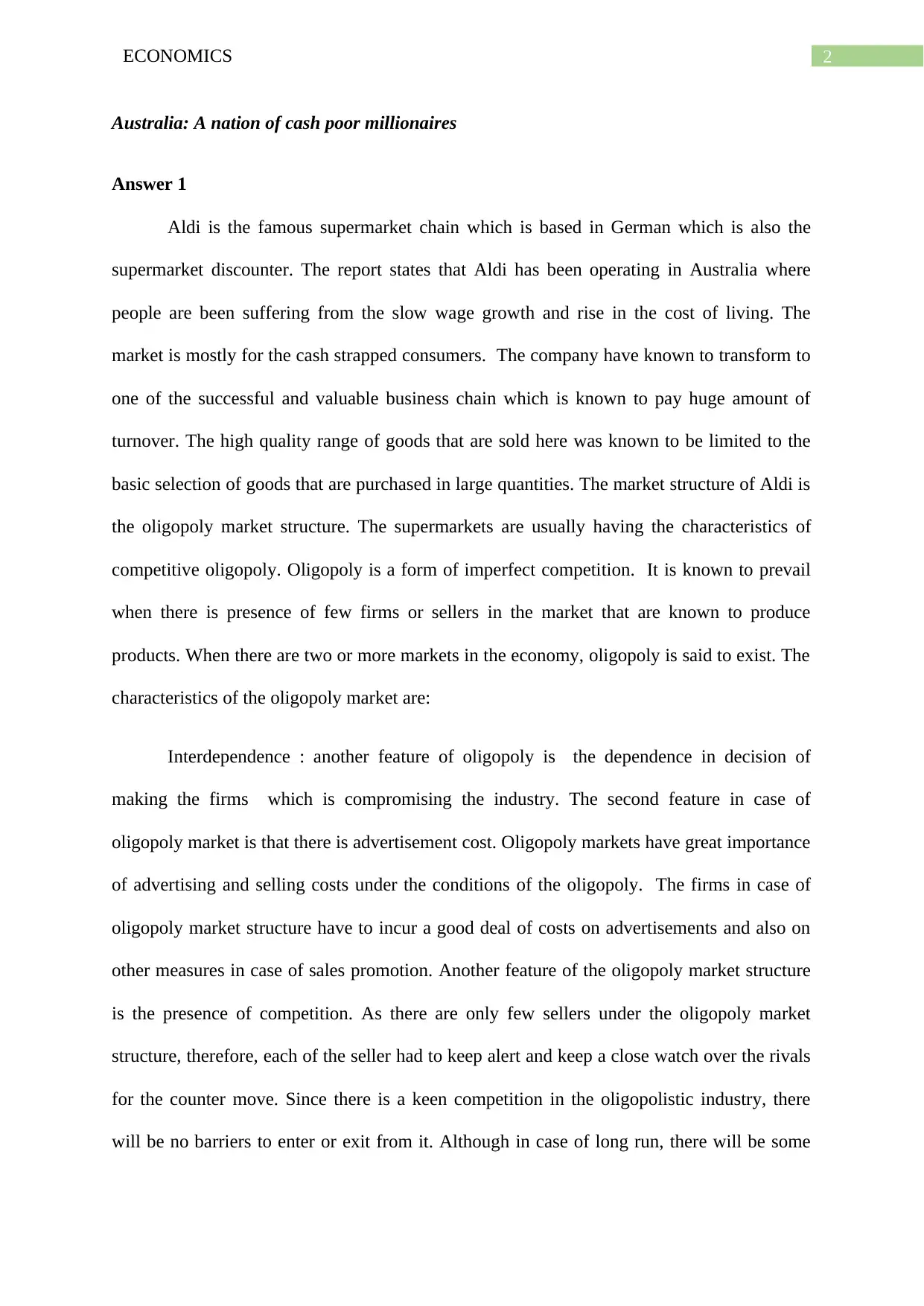
2ECONOMICS
Australia: A nation of cash poor millionaires
Answer 1
Aldi is the famous supermarket chain which is based in German which is also the
supermarket discounter. The report states that Aldi has been operating in Australia where
people are been suffering from the slow wage growth and rise in the cost of living. The
market is mostly for the cash strapped consumers. The company have known to transform to
one of the successful and valuable business chain which is known to pay huge amount of
turnover. The high quality range of goods that are sold here was known to be limited to the
basic selection of goods that are purchased in large quantities. The market structure of Aldi is
the oligopoly market structure. The supermarkets are usually having the characteristics of
competitive oligopoly. Oligopoly is a form of imperfect competition. It is known to prevail
when there is presence of few firms or sellers in the market that are known to produce
products. When there are two or more markets in the economy, oligopoly is said to exist. The
characteristics of the oligopoly market are:
Interdependence : another feature of oligopoly is the dependence in decision of
making the firms which is compromising the industry. The second feature in case of
oligopoly market is that there is advertisement cost. Oligopoly markets have great importance
of advertising and selling costs under the conditions of the oligopoly. The firms in case of
oligopoly market structure have to incur a good deal of costs on advertisements and also on
other measures in case of sales promotion. Another feature of the oligopoly market structure
is the presence of competition. As there are only few sellers under the oligopoly market
structure, therefore, each of the seller had to keep alert and keep a close watch over the rivals
for the counter move. Since there is a keen competition in the oligopolistic industry, there
will be no barriers to enter or exit from it. Although in case of long run, there will be some
Australia: A nation of cash poor millionaires
Answer 1
Aldi is the famous supermarket chain which is based in German which is also the
supermarket discounter. The report states that Aldi has been operating in Australia where
people are been suffering from the slow wage growth and rise in the cost of living. The
market is mostly for the cash strapped consumers. The company have known to transform to
one of the successful and valuable business chain which is known to pay huge amount of
turnover. The high quality range of goods that are sold here was known to be limited to the
basic selection of goods that are purchased in large quantities. The market structure of Aldi is
the oligopoly market structure. The supermarkets are usually having the characteristics of
competitive oligopoly. Oligopoly is a form of imperfect competition. It is known to prevail
when there is presence of few firms or sellers in the market that are known to produce
products. When there are two or more markets in the economy, oligopoly is said to exist. The
characteristics of the oligopoly market are:
Interdependence : another feature of oligopoly is the dependence in decision of
making the firms which is compromising the industry. The second feature in case of
oligopoly market is that there is advertisement cost. Oligopoly markets have great importance
of advertising and selling costs under the conditions of the oligopoly. The firms in case of
oligopoly market structure have to incur a good deal of costs on advertisements and also on
other measures in case of sales promotion. Another feature of the oligopoly market structure
is the presence of competition. As there are only few sellers under the oligopoly market
structure, therefore, each of the seller had to keep alert and keep a close watch over the rivals
for the counter move. Since there is a keen competition in the oligopolistic industry, there
will be no barriers to enter or exit from it. Although in case of long run, there will be some
⊘ This is a preview!⊘
Do you want full access?
Subscribe today to unlock all pages.

Trusted by 1+ million students worldwide
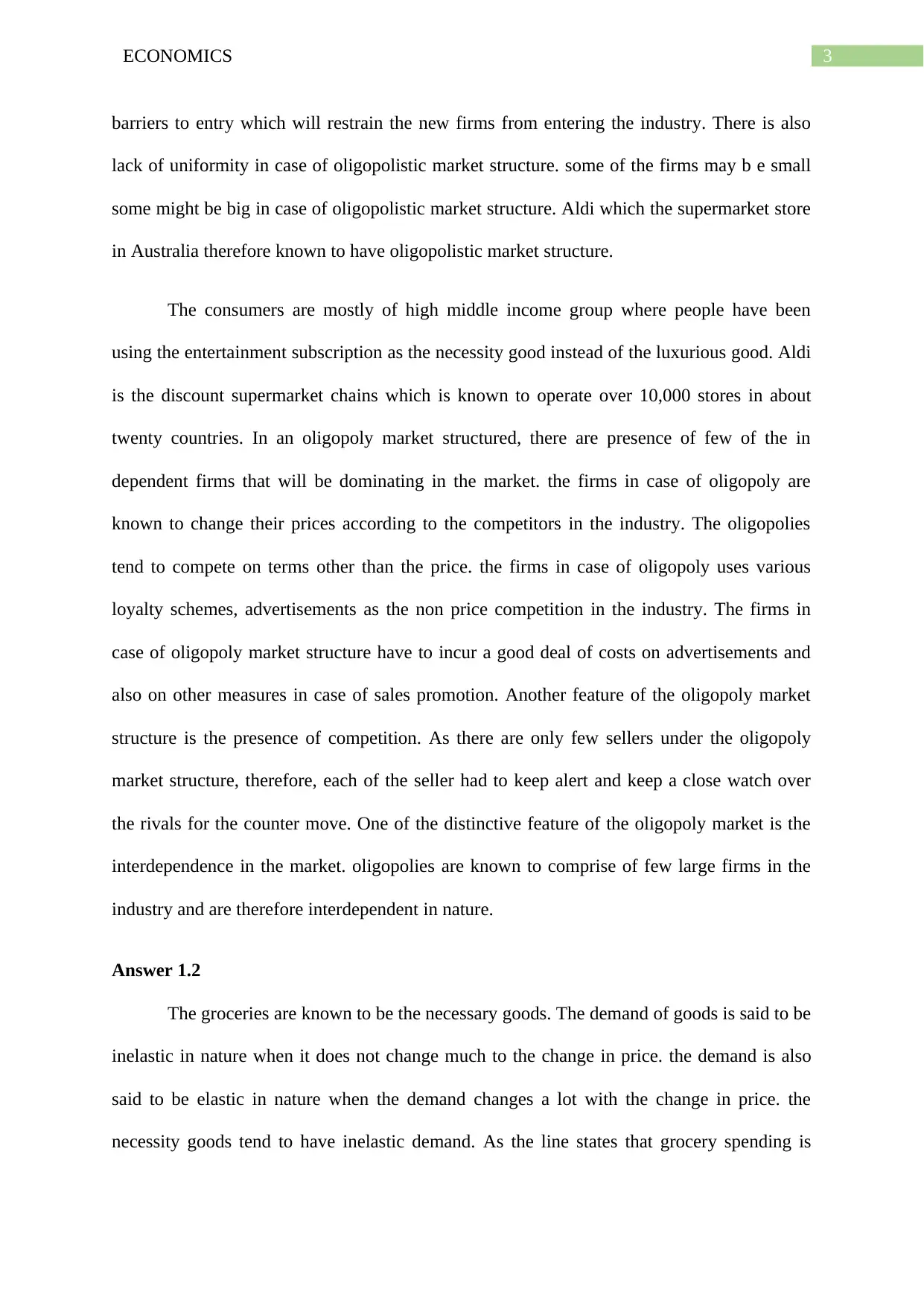
3ECONOMICS
barriers to entry which will restrain the new firms from entering the industry. There is also
lack of uniformity in case of oligopolistic market structure. some of the firms may b e small
some might be big in case of oligopolistic market structure. Aldi which the supermarket store
in Australia therefore known to have oligopolistic market structure.
The consumers are mostly of high middle income group where people have been
using the entertainment subscription as the necessity good instead of the luxurious good. Aldi
is the discount supermarket chains which is known to operate over 10,000 stores in about
twenty countries. In an oligopoly market structured, there are presence of few of the in
dependent firms that will be dominating in the market. the firms in case of oligopoly are
known to change their prices according to the competitors in the industry. The oligopolies
tend to compete on terms other than the price. the firms in case of oligopoly uses various
loyalty schemes, advertisements as the non price competition in the industry. The firms in
case of oligopoly market structure have to incur a good deal of costs on advertisements and
also on other measures in case of sales promotion. Another feature of the oligopoly market
structure is the presence of competition. As there are only few sellers under the oligopoly
market structure, therefore, each of the seller had to keep alert and keep a close watch over
the rivals for the counter move. One of the distinctive feature of the oligopoly market is the
interdependence in the market. oligopolies are known to comprise of few large firms in the
industry and are therefore interdependent in nature.
Answer 1.2
The groceries are known to be the necessary goods. The demand of goods is said to be
inelastic in nature when it does not change much to the change in price. the demand is also
said to be elastic in nature when the demand changes a lot with the change in price. the
necessity goods tend to have inelastic demand. As the line states that grocery spending is
barriers to entry which will restrain the new firms from entering the industry. There is also
lack of uniformity in case of oligopolistic market structure. some of the firms may b e small
some might be big in case of oligopolistic market structure. Aldi which the supermarket store
in Australia therefore known to have oligopolistic market structure.
The consumers are mostly of high middle income group where people have been
using the entertainment subscription as the necessity good instead of the luxurious good. Aldi
is the discount supermarket chains which is known to operate over 10,000 stores in about
twenty countries. In an oligopoly market structured, there are presence of few of the in
dependent firms that will be dominating in the market. the firms in case of oligopoly are
known to change their prices according to the competitors in the industry. The oligopolies
tend to compete on terms other than the price. the firms in case of oligopoly uses various
loyalty schemes, advertisements as the non price competition in the industry. The firms in
case of oligopoly market structure have to incur a good deal of costs on advertisements and
also on other measures in case of sales promotion. Another feature of the oligopoly market
structure is the presence of competition. As there are only few sellers under the oligopoly
market structure, therefore, each of the seller had to keep alert and keep a close watch over
the rivals for the counter move. One of the distinctive feature of the oligopoly market is the
interdependence in the market. oligopolies are known to comprise of few large firms in the
industry and are therefore interdependent in nature.
Answer 1.2
The groceries are known to be the necessary goods. The demand of goods is said to be
inelastic in nature when it does not change much to the change in price. the demand is also
said to be elastic in nature when the demand changes a lot with the change in price. the
necessity goods tend to have inelastic demand. As the line states that grocery spending is
Paraphrase This Document
Need a fresh take? Get an instant paraphrase of this document with our AI Paraphraser
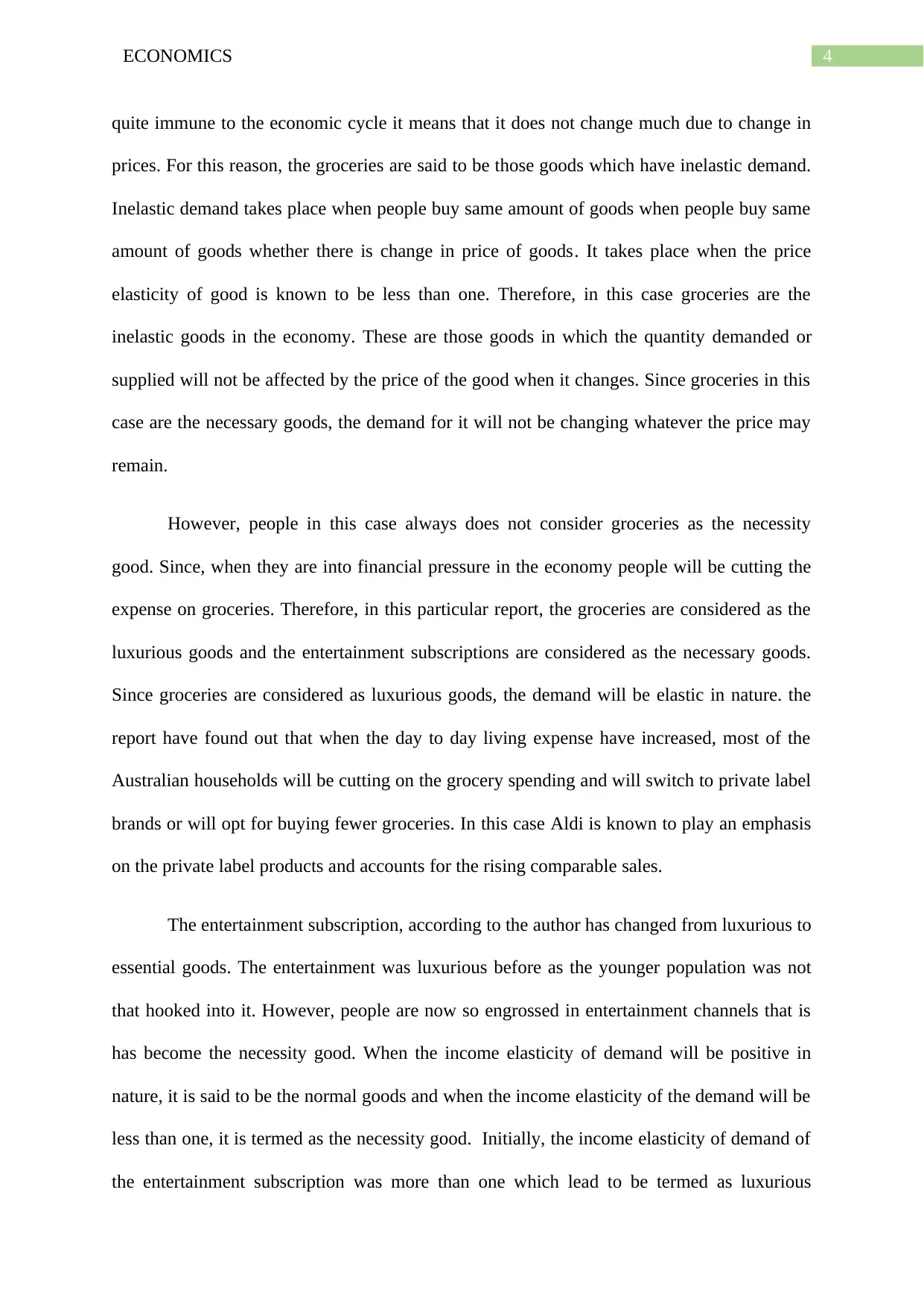
4ECONOMICS
quite immune to the economic cycle it means that it does not change much due to change in
prices. For this reason, the groceries are said to be those goods which have inelastic demand.
Inelastic demand takes place when people buy same amount of goods when people buy same
amount of goods whether there is change in price of goods. It takes place when the price
elasticity of good is known to be less than one. Therefore, in this case groceries are the
inelastic goods in the economy. These are those goods in which the quantity demanded or
supplied will not be affected by the price of the good when it changes. Since groceries in this
case are the necessary goods, the demand for it will not be changing whatever the price may
remain.
However, people in this case always does not consider groceries as the necessity
good. Since, when they are into financial pressure in the economy people will be cutting the
expense on groceries. Therefore, in this particular report, the groceries are considered as the
luxurious goods and the entertainment subscriptions are considered as the necessary goods.
Since groceries are considered as luxurious goods, the demand will be elastic in nature. the
report have found out that when the day to day living expense have increased, most of the
Australian households will be cutting on the grocery spending and will switch to private label
brands or will opt for buying fewer groceries. In this case Aldi is known to play an emphasis
on the private label products and accounts for the rising comparable sales.
The entertainment subscription, according to the author has changed from luxurious to
essential goods. The entertainment was luxurious before as the younger population was not
that hooked into it. However, people are now so engrossed in entertainment channels that is
has become the necessity good. When the income elasticity of demand will be positive in
nature, it is said to be the normal goods and when the income elasticity of the demand will be
less than one, it is termed as the necessity good. Initially, the income elasticity of demand of
the entertainment subscription was more than one which lead to be termed as luxurious
quite immune to the economic cycle it means that it does not change much due to change in
prices. For this reason, the groceries are said to be those goods which have inelastic demand.
Inelastic demand takes place when people buy same amount of goods when people buy same
amount of goods whether there is change in price of goods. It takes place when the price
elasticity of good is known to be less than one. Therefore, in this case groceries are the
inelastic goods in the economy. These are those goods in which the quantity demanded or
supplied will not be affected by the price of the good when it changes. Since groceries in this
case are the necessary goods, the demand for it will not be changing whatever the price may
remain.
However, people in this case always does not consider groceries as the necessity
good. Since, when they are into financial pressure in the economy people will be cutting the
expense on groceries. Therefore, in this particular report, the groceries are considered as the
luxurious goods and the entertainment subscriptions are considered as the necessary goods.
Since groceries are considered as luxurious goods, the demand will be elastic in nature. the
report have found out that when the day to day living expense have increased, most of the
Australian households will be cutting on the grocery spending and will switch to private label
brands or will opt for buying fewer groceries. In this case Aldi is known to play an emphasis
on the private label products and accounts for the rising comparable sales.
The entertainment subscription, according to the author has changed from luxurious to
essential goods. The entertainment was luxurious before as the younger population was not
that hooked into it. However, people are now so engrossed in entertainment channels that is
has become the necessity good. When the income elasticity of demand will be positive in
nature, it is said to be the normal goods and when the income elasticity of the demand will be
less than one, it is termed as the necessity good. Initially, the income elasticity of demand of
the entertainment subscription was more than one which lead to be termed as luxurious
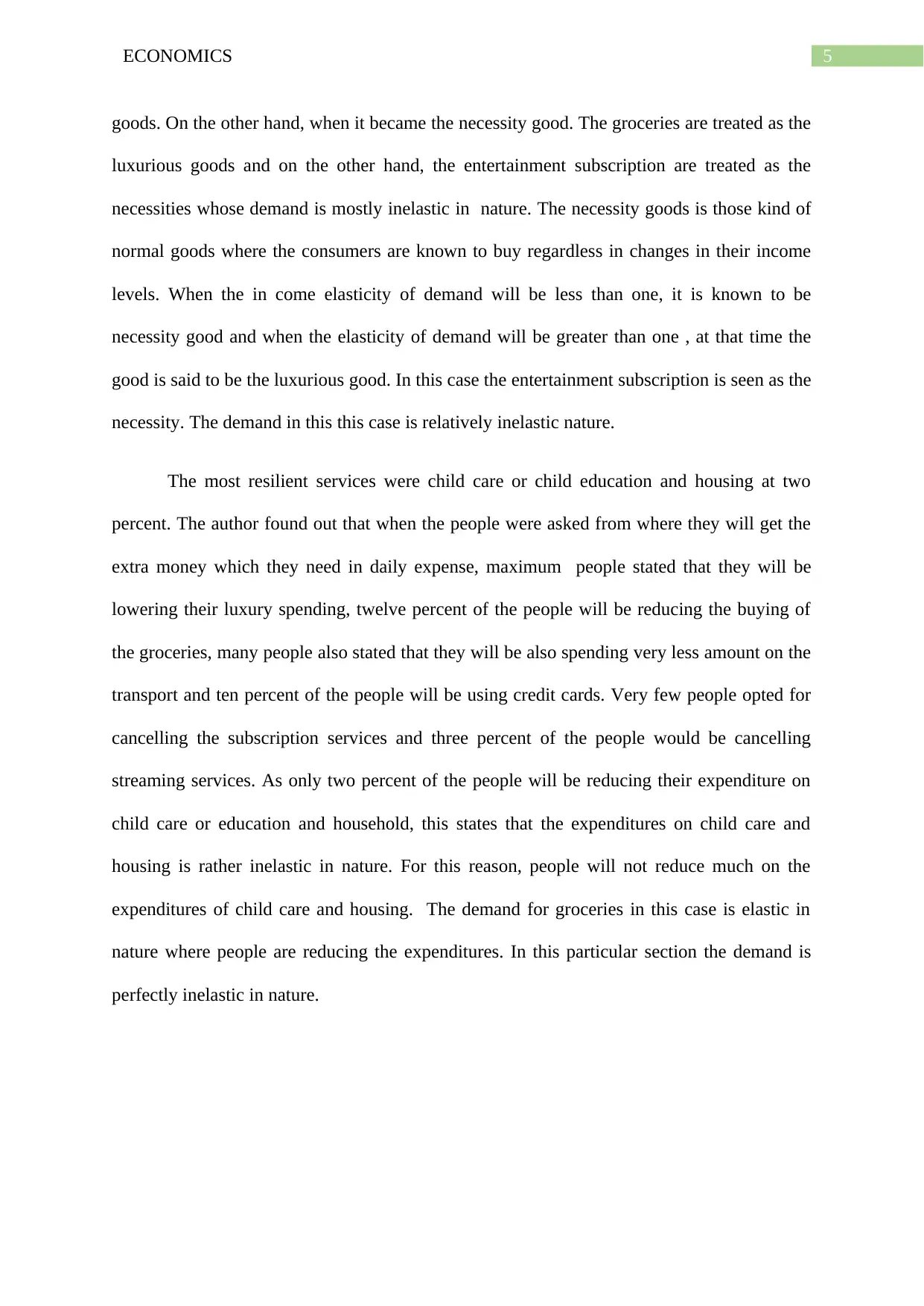
5ECONOMICS
goods. On the other hand, when it became the necessity good. The groceries are treated as the
luxurious goods and on the other hand, the entertainment subscription are treated as the
necessities whose demand is mostly inelastic in nature. The necessity goods is those kind of
normal goods where the consumers are known to buy regardless in changes in their income
levels. When the in come elasticity of demand will be less than one, it is known to be
necessity good and when the elasticity of demand will be greater than one , at that time the
good is said to be the luxurious good. In this case the entertainment subscription is seen as the
necessity. The demand in this this case is relatively inelastic nature.
The most resilient services were child care or child education and housing at two
percent. The author found out that when the people were asked from where they will get the
extra money which they need in daily expense, maximum people stated that they will be
lowering their luxury spending, twelve percent of the people will be reducing the buying of
the groceries, many people also stated that they will be also spending very less amount on the
transport and ten percent of the people will be using credit cards. Very few people opted for
cancelling the subscription services and three percent of the people would be cancelling
streaming services. As only two percent of the people will be reducing their expenditure on
child care or education and household, this states that the expenditures on child care and
housing is rather inelastic in nature. For this reason, people will not reduce much on the
expenditures of child care and housing. The demand for groceries in this case is elastic in
nature where people are reducing the expenditures. In this particular section the demand is
perfectly inelastic in nature.
goods. On the other hand, when it became the necessity good. The groceries are treated as the
luxurious goods and on the other hand, the entertainment subscription are treated as the
necessities whose demand is mostly inelastic in nature. The necessity goods is those kind of
normal goods where the consumers are known to buy regardless in changes in their income
levels. When the in come elasticity of demand will be less than one, it is known to be
necessity good and when the elasticity of demand will be greater than one , at that time the
good is said to be the luxurious good. In this case the entertainment subscription is seen as the
necessity. The demand in this this case is relatively inelastic nature.
The most resilient services were child care or child education and housing at two
percent. The author found out that when the people were asked from where they will get the
extra money which they need in daily expense, maximum people stated that they will be
lowering their luxury spending, twelve percent of the people will be reducing the buying of
the groceries, many people also stated that they will be also spending very less amount on the
transport and ten percent of the people will be using credit cards. Very few people opted for
cancelling the subscription services and three percent of the people would be cancelling
streaming services. As only two percent of the people will be reducing their expenditure on
child care or education and household, this states that the expenditures on child care and
housing is rather inelastic in nature. For this reason, people will not reduce much on the
expenditures of child care and housing. The demand for groceries in this case is elastic in
nature where people are reducing the expenditures. In this particular section the demand is
perfectly inelastic in nature.
⊘ This is a preview!⊘
Do you want full access?
Subscribe today to unlock all pages.

Trusted by 1+ million students worldwide
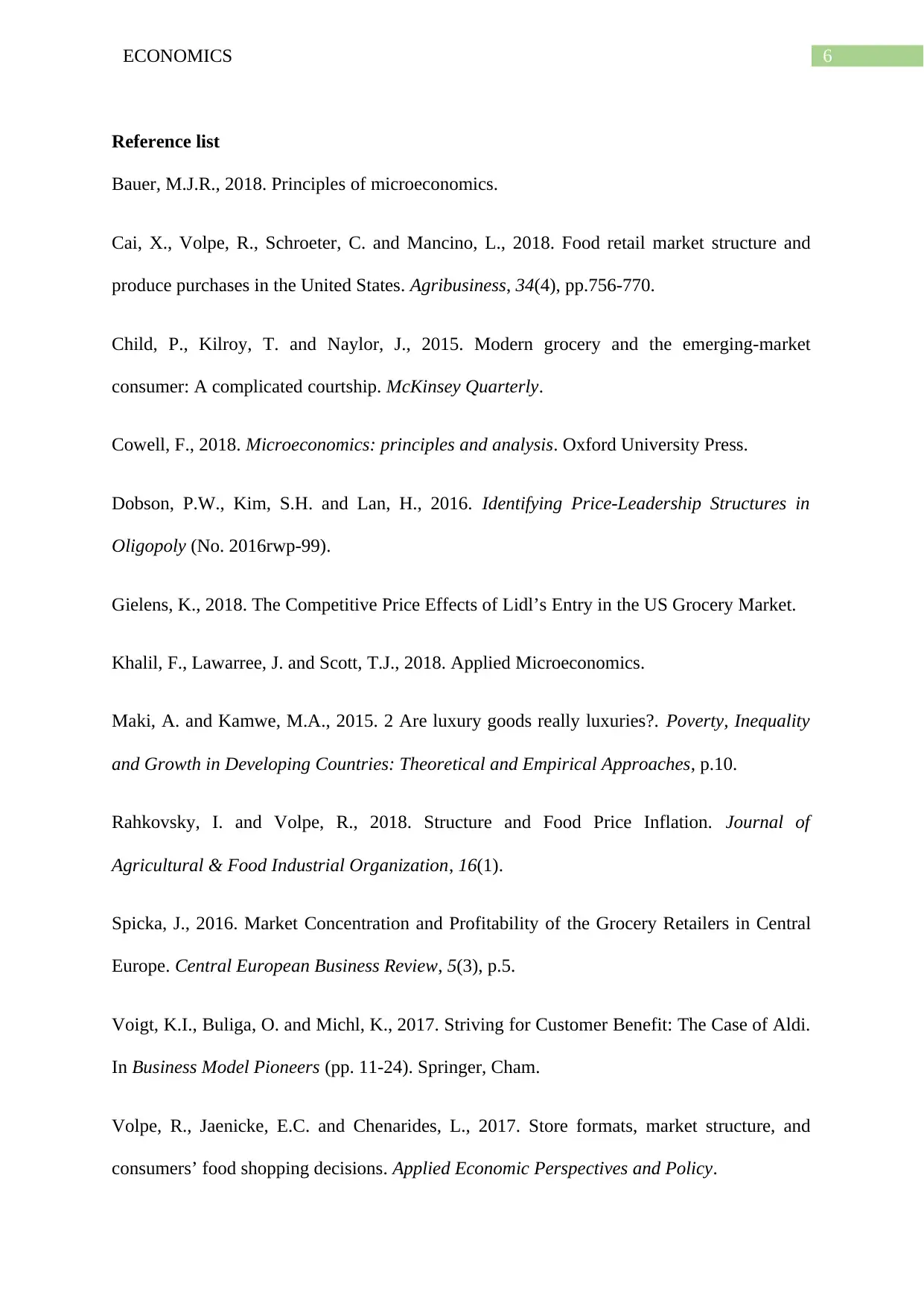
6ECONOMICS
Reference list
Bauer, M.J.R., 2018. Principles of microeconomics.
Cai, X., Volpe, R., Schroeter, C. and Mancino, L., 2018. Food retail market structure and
produce purchases in the United States. Agribusiness, 34(4), pp.756-770.
Child, P., Kilroy, T. and Naylor, J., 2015. Modern grocery and the emerging-market
consumer: A complicated courtship. McKinsey Quarterly.
Cowell, F., 2018. Microeconomics: principles and analysis. Oxford University Press.
Dobson, P.W., Kim, S.H. and Lan, H., 2016. Identifying Price-Leadership Structures in
Oligopoly (No. 2016rwp-99).
Gielens, K., 2018. The Competitive Price Effects of Lidl’s Entry in the US Grocery Market.
Khalil, F., Lawarree, J. and Scott, T.J., 2018. Applied Microeconomics.
Maki, A. and Kamwe, M.A., 2015. 2 Are luxury goods really luxuries?. Poverty, Inequality
and Growth in Developing Countries: Theoretical and Empirical Approaches, p.10.
Rahkovsky, I. and Volpe, R., 2018. Structure and Food Price Inflation. Journal of
Agricultural & Food Industrial Organization, 16(1).
Spicka, J., 2016. Market Concentration and Profitability of the Grocery Retailers in Central
Europe. Central European Business Review, 5(3), p.5.
Voigt, K.I., Buliga, O. and Michl, K., 2017. Striving for Customer Benefit: The Case of Aldi.
In Business Model Pioneers (pp. 11-24). Springer, Cham.
Volpe, R., Jaenicke, E.C. and Chenarides, L., 2017. Store formats, market structure, and
consumers’ food shopping decisions. Applied Economic Perspectives and Policy.
Reference list
Bauer, M.J.R., 2018. Principles of microeconomics.
Cai, X., Volpe, R., Schroeter, C. and Mancino, L., 2018. Food retail market structure and
produce purchases in the United States. Agribusiness, 34(4), pp.756-770.
Child, P., Kilroy, T. and Naylor, J., 2015. Modern grocery and the emerging-market
consumer: A complicated courtship. McKinsey Quarterly.
Cowell, F., 2018. Microeconomics: principles and analysis. Oxford University Press.
Dobson, P.W., Kim, S.H. and Lan, H., 2016. Identifying Price-Leadership Structures in
Oligopoly (No. 2016rwp-99).
Gielens, K., 2018. The Competitive Price Effects of Lidl’s Entry in the US Grocery Market.
Khalil, F., Lawarree, J. and Scott, T.J., 2018. Applied Microeconomics.
Maki, A. and Kamwe, M.A., 2015. 2 Are luxury goods really luxuries?. Poverty, Inequality
and Growth in Developing Countries: Theoretical and Empirical Approaches, p.10.
Rahkovsky, I. and Volpe, R., 2018. Structure and Food Price Inflation. Journal of
Agricultural & Food Industrial Organization, 16(1).
Spicka, J., 2016. Market Concentration and Profitability of the Grocery Retailers in Central
Europe. Central European Business Review, 5(3), p.5.
Voigt, K.I., Buliga, O. and Michl, K., 2017. Striving for Customer Benefit: The Case of Aldi.
In Business Model Pioneers (pp. 11-24). Springer, Cham.
Volpe, R., Jaenicke, E.C. and Chenarides, L., 2017. Store formats, market structure, and
consumers’ food shopping decisions. Applied Economic Perspectives and Policy.
Paraphrase This Document
Need a fresh take? Get an instant paraphrase of this document with our AI Paraphraser

7ECONOMICS
1 out of 8
Related Documents
Your All-in-One AI-Powered Toolkit for Academic Success.
+13062052269
info@desklib.com
Available 24*7 on WhatsApp / Email
![[object Object]](/_next/static/media/star-bottom.7253800d.svg)
Unlock your academic potential
Copyright © 2020–2025 A2Z Services. All Rights Reserved. Developed and managed by ZUCOL.





